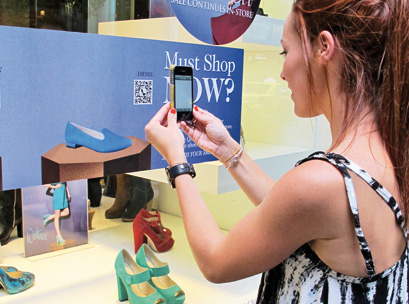There’s currently a case study doing the rounds at retail conferences, marketing meetings, and in trend reports.
If you don’t know it, then you’ve likely been snoring. The constant repetition has, after all, started to become mildly yawn-inducing.
(Hint: it starts with a T and involves the subway.)
“I think we all saw what Tesco did in Korea last year,” says Michael Wittner, CEO of national women’s footwear chain, Wittner.
For those in the cheap seats up the back: since launching in June last year, the UK supermarket has enthralled the global market with its virtual stores on South Korean train platforms.
It was an undoubtedly trendsetting move. So much so that less than a year later, Tesco is giving Australian retailers something new to talk about: themselves.
Supermarket chain, Woolworths, is one of the first local retailers to grab hold of the trend, with a premiere in February almost identical to Tesco’s lead.
Its wall installation at Town Hall, Sydney’s busiest train station, features 120 pictures of its most popular products, from toiletries to fresh produce.
Tjeerd Jegen, Woolworths director of supermarkets, calls the move, which requires the download of a free smartphone app, part of “a mobile shopping revolution”.
“Sydney commuters going through Town Hall station will be the first in Australia to experience the cutting edge of supermarket innovation,” he said at its launch.
It’s also a decision that expands the chain’s online sales to a widely receptive audience at a fraction of the price of opening new bricks and mortar sites.
The supermarket is not alone in recognising the trend’s potential.
Shortly after the Woolworths’ launch, another retailer, The Co-op Bookshop, expanded the footprint of its existing stores by building upon the “virtual supermarket” model at several universities across Australia.
Its concept doesn’t target new roving audiences at quite the same level as Woolworths or Tesco, however, taps into young customers’ desires for fast transactions that are both innovative and fun.
Greg Smith, CCO of The Co-op Bookshop, says the QR codes – one for each of its 36 most popular titles – installed on external windows gives busy students “the opportunity to get their text books using a new and exciting channel”.
It also sees them avoid the hectic queues that accumulate at the start of each university semester and, much like the supermarkets, offers free of charge delivery to the roving buyer’s front door.
“It’s admittedly not that different to buying online, but a lot of students are on campus and they go along to our shops. It’s therefore another channel and is obviously a lot faster for them,” says Smith.


Fashion first
It’s not just bookshops and supermarkets latching onto the trend in Australia.
In fact, it appears that when it comes to window shopping v2.0, the fashion industry beat the others to the streets.
“Ours actually commenced rolling out the day before Woolworths released news of theirs,” laughs that earlier fan of Tesco, Michael Wittner, of the family-owned footwear chain’s ‘Scan and Go’ concept.
He says Wittner’s QR window installations, which have so far been rolled out at five sites across Australia, are about bringing back “the interactive experience”.
“Even my daughters are saying they’re sick of buying online and they want to get back to shopping in the centres, but they want a more futuristic experience.”
The installation capitalises on a specific type of window shopper on strip precincts: the night time rover. They’re the sort of shoppers (mostly young and female) that stop to gawk in windows, but until now had no direct path to purchase offered to them by the retailer.
Combined with good lighting of highlighted product in the flesh, ‘Scan and Go’ capitalises on the millions of spontaneous buyers that are increasingly using their smartphones to shop online.
Prue Thomas, strategic brand manager at Sportsgirl, agrees that installations like this capitalise on the omni-channel revolution, and also serve as a constant brand reminder to roving pedestrians.
“It reinforces the message that our girl can shop 24/7 regardless of whether she has the time to pop into a store or shop on the move,” says Thomas.
Sportsgirl’s QR window decals highlight its “upper echelon” of product, like best-selling shoe styles, in an installation only notably beaten to the punch by another fashion name, Net-A-Porter, in January.
Installed in a shopfront in Sydney’s Bondi and unveiled in tandem with sites in London, New York, and Berlin, the pop up for the UK-based e-commerce site’s Karl Lagerfeld diffusion label is indicative of the retailers most likely to benefit from this trend: pure play e-tailers.
Virtual windows, while relatively inexpensive to install, require effective back of house systems, which means those already adept at online and e-commerce are most likely to thrive with its use.
The Co-op Bookshop spent less than $3000 for “a strong” ROI and buzz among students.
“We think it’s important to start in one area and evolve. We’ve received great feedback from students especially around the concept in general and in relation to the reduction in queuing time,” says Smith.
It mightn’t be for everybody but, given the breadth of retailers picking up on this trend in the last four months, the Australian market is certainly giving Tesco a run for its money.
* This feature first appeared in the April/May 2012 edition of Inside Retail Magazine. For more stories like this, subscribe to Inside Retail Magazine’s bi-monthly print edition here






